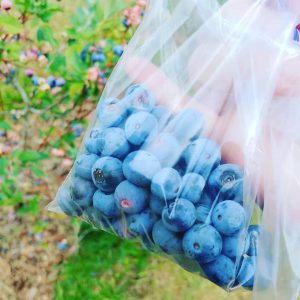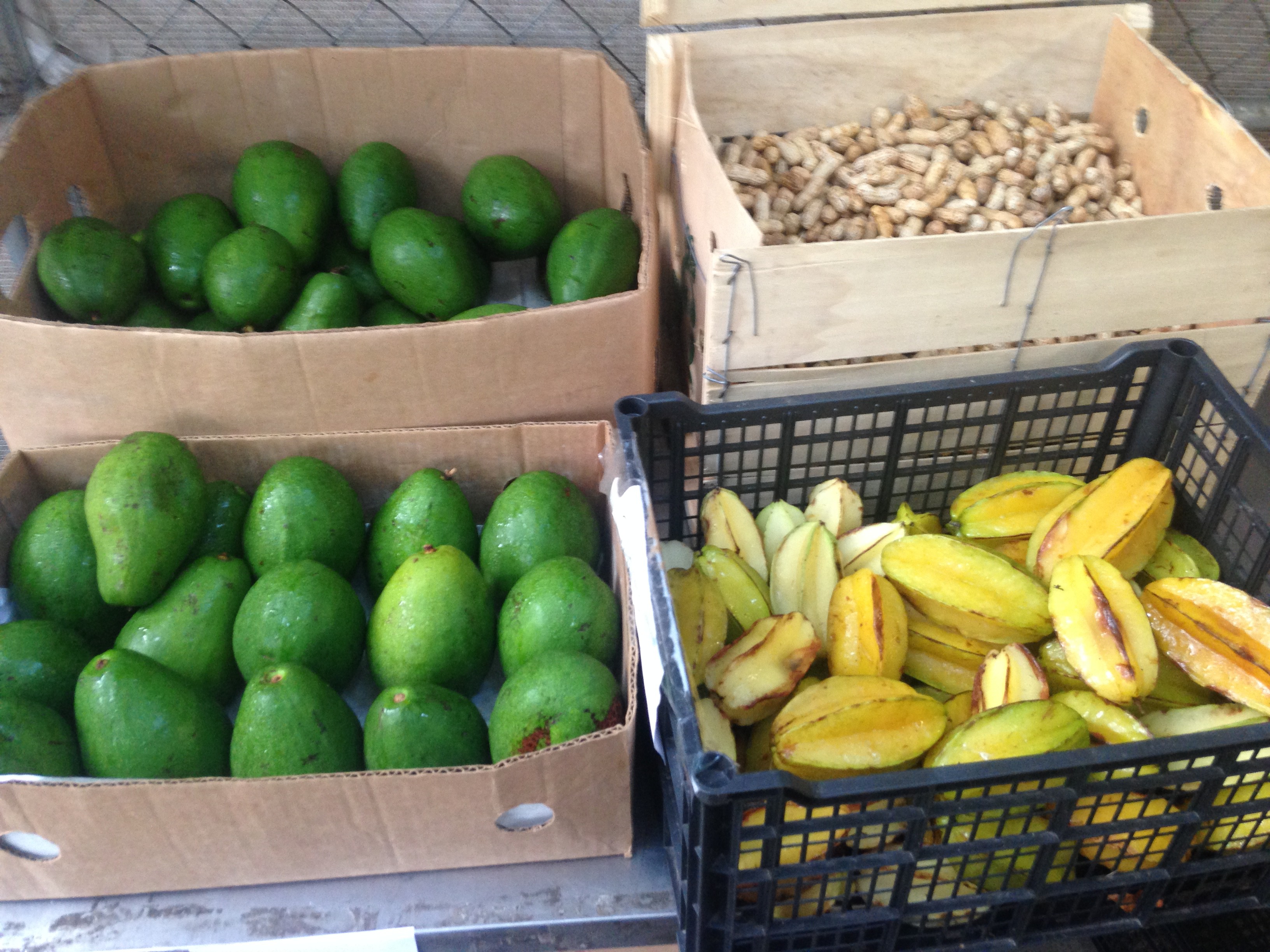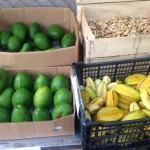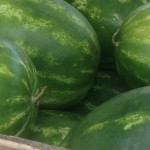
by Stephanie Herzog | Jul 25, 2019

Eating fresh, local produce is a great way to be healthier, save money, and support the local economy. (Photo source: Stephanie Herzog)
Summer Local Eats – Supporting Farmers’ Markets
Summer is a great time of year to eat locally grown fresh produce! There are many options rich in a variety of colors, shapes, sizes, and nutrients. Farmers work hard to provide life-sustaining sustenance for society, and consumers supporting their efforts at the local level has an array of health and economic benefits.
Fresh summer crops in the panhandle abound. Produce that is ready this time of year includes peppers, cucumber, peanuts, okra, squash, corn, and watermelon. Spice up a summer salad with fresh cucumbers or peppers or try tasty yellow meat watermelon for a chill and nutritious summertime snack! Local, fresh produce is a healthy alternative to processed foods or produce found in grocery stores. Produce sold by local farmers is freshly picked and because you know where it comes from, it is both safer to eat and keeps for longer periods of time than grocery store produce, which often has traveled long distances, is seldom inspected, and is kept in storage before finally being put out on the floor for purchase.
Supporting your farmers’ market benefits both you and your community in many ways. Purchasing from local farmers and farmers’ markets is both financially sound for you and is supportive of the community’s economy – the money changes hands locally and creates and maintains jobs. Not only does it benefit the economy, it also fosters a stronger sense of community unity and trusted relationships, which is vital to any successful society and local economy. For example, farmers will sometimes offer a “u-pick” program, depending on the crop, where you go to their farm and pick what produce you want right from the field! You get to keep half, and the farmer keeps half. This is a great cooperative effort that benefits everyone – you get free, fresh produce, and the farmer gets free labor. Who doesn’t love a win-win scenario?
Jackson County farmers’ markets information. Residents in Jackson County have a wonderful farmers’ market in the heart of downtown Marianna, located at Madison Street Park (2881 Madison St.) that goes throughout the summer every Tuesday, Thursday, and Saturday morning from 7am-12pm. After September, the market will continue through the fall, winter, and spring each Saturday at the same time. Tuesday and Thursday have farmer vendors only, while Saturday includes a variety of vendors, such as arts and crafts, plants and flowers, jams, jellies, honey, etc. This market also offers a raffle when you purchase items from vendors! For any questions about the market or how to join as a vendor, visit their Facebook page or contact Tony Mayo, the current farmers’ market manager or Terry Johnson, the public relations manager for the market. His number is 850-592-5114. It’s a good idea to bring cash or checks, but some vendors do accept credit and debit cards.
Want to find a farmers’ market near you or learn more about the benefits and best practices shopping at a farmers’ market?
Come experience the buzz and benefits of the farmers’ market!
Sources:
Local farmers at the Marianna City Farmers’ Market
Wang, Q., Evans, E. A., Pikarsky, M., & Olczyk, T. Consuming local vegetables from our local growers. UF IFAS publication HS1251.

by Heidi Copeland | Aug 24, 2015
 Local, seasonal food has been the subject of federal, state, and local government policy in recent years as consumer interest in and demand for this kind of food has grown. In fact, research from the UF/IFAS Center for Public Issues Education (piecenter.com/local) shows Floridians spent $8.3 billion on local food in 2012. Not only is this dollar amount continuing to grow, consumers are continuing to look for more local food options. In fact, they are interested in most anything offered and flexible about what they purchase!
Local, seasonal food has been the subject of federal, state, and local government policy in recent years as consumer interest in and demand for this kind of food has grown. In fact, research from the UF/IFAS Center for Public Issues Education (piecenter.com/local) shows Floridians spent $8.3 billion on local food in 2012. Not only is this dollar amount continuing to grow, consumers are continuing to look for more local food options. In fact, they are interested in most anything offered and flexible about what they purchase!
Still, there is no consensus about how to define “local food systems.” Is it local because of geographic distance? Or is it local because it is grown within the state? Are there exceptions when the products you want are available or are out of season? Whatever your standard definition for local food, consumers are eating it up!
Retail grocery stores, farmers markets, Community Supported Agriculture (CSAs), roadside stands, U-pick operations, and restaurants were among the most popular places the aforementioned research found consumers purchasing their local food. Additionally, consumers want this food easy to access, high in quality and not too high-priced.
Both the United States Department of Agriculture (USDA) and the Florida Department of Agriculture and Consumer Services (FDACS) support this growing movement. USDA’s National Farmers Market Directory provides consumers with convenient access to information about farmers market listings to include: market locations, directions, operating times, product offerings, accepted forms of payment, and more. (http://search.ams.usda.gov/farmersmarkets)
FDACS maintains a list of community farmers markets throughout Florida, but, because community farmers markets are not required to register with the Department, the list is not a complete one. Being listed does not imply that a market is endorsed, approved, or otherwise sanctioned by FDACS. (http://www.freshfromflorida.com/Divisions-Offices/Marketing-and-Development/Consumer-Resources/Buy-Fresh-From-Florida/Community-Farmers-Markets)
According to FDACS, Fresh From Florida produce available during the month of August includes: avocado, carambola, guava, longan, lychee, mango, mushroom, passion fruit, and peanuts.
So many opportunities exist for folks to eat healthy and seasonally. Are you getting your share? Stop by your favorite source and stock up on what’s Florida-fresh this month!
http://www.freshfromflorida.com/Divisions-Offices/Marketing-and-Development/Consumer-Resources/Buy-Fresh-From-Florida/Crops-in-Season

by Heidi Copeland | Jun 5, 2015
 Rarely do I hear the phrase “school’s out” and not think of my own summers of fun and, of course, Alice Cooper’s 1972 major hit single “School’s Out for Summer” – does that age me?
Rarely do I hear the phrase “school’s out” and not think of my own summers of fun and, of course, Alice Cooper’s 1972 major hit single “School’s Out for Summer” – does that age me?
In fact, “word” has it that Alice Cooper said he was inspired to write the song when answering the question, “What are the greatest three minutes of your life?” Cooper said: “There are two times …The second one being “the last three minutes of the last day of school!”
Summer break is here and that may mean time for a big change to your daily routine. Even though summertime is fun, there still can be challenges for families who have to juggle and adjust!
The key is to plan ahead. Being prepared helps you enjoy the long days of summer. This is especially true when it comes to summer food. Kids associate summer with FUN. Much more fun can be had if you don’t have to spend time in the kitchen – cooking! (But that, too, can be enjoyable!)
Summer is an amazing time! There is an abundance of fresh, delicious, and healthy choices bursting with health benefits. Best yet, many of these foods do not even have to be cooked! With a general washing and perhaps a bit of slicing and dicing, many summer foods can be eaten without further preparation.
One of my favorites is watermelon! It’s like drinking your water and eating it, too! Watermelon helps keep you hydrated (watermelon is 92 percent water). Plus, one cup of diced watermelon contains 43 calories, 0 grams of fat, 2 grams of sodium, 11 grams of carbohydrate, and 1 gram of fiber. One cup of watermelon will provide 17% of vitamin A, 21% of vitamin C, 2% of iron, and 1% of calcium needs for the day. Watermelon also contains thiamin, riboflavin, niacin, vitamin B-6, folate, pantothenic acid, magnesium, phosphorus, potassium, zinc, copper, manganese, selenium, choline, lycopene, and betaine. And, according to the National Watermelon Promotion Board, watermelon contains more skin- protecting lycopene than any other fruit or vegetable (lycopene also gives watermelon its bright pink color). Research shows that eating foods that are full of water helps keep you satisfied on fewer calories.
Watermelon actually is considered a nutrient-dense food – it provides a high amount of vitamins, minerals, and antioxidants for a low number of calories.
But don’t stop at watermelon. The Florida Department of Agriculture and Consumer Services has a fantastic website promoting buying “Fresh From Florida.” In fact, their website devotes an entire section to “Fresh from Florida Foods.” This month, June, we have quite a bounty to be thankful for. Not only are the foods on this list nutritious, they are delicious and, for the most part, many require little preparation to be consumed (plus, food in season generally is less expensive and tastes better).
Print yourself a copy of What’s in Season Now and go have some summer fun!
Just in case you don’t have time to print the list, here is what is in season now….avocado, cantaloupe, eggplant, guava, lychee, mango, mushroom, orange, papaya, passion fruit, peanut, potato, sweet corn, tomato, and watermelon. Look for these foods at local farmers’ markets or in your supermarket’s produce section.
Enjoy the tastes of summer from the Sunshine State!






